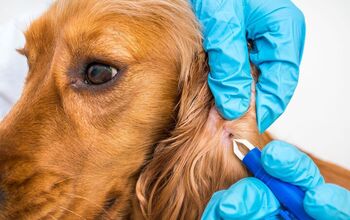Understanding Testicular and Ovotesticular Disorder in Dogs

Though many of the health problems seen in dogs are vastly different from the kind of issues that affect humans, there is some overlap. One of the rarer conditions that you may be familiar with in humans that can also sometimes affect dogs is called hermaphroditism. Though the word hermaphrodite may conjure an image of some kind of anatomical disaster, there are different variations on the disorder and it is not always obvious. Keep reading to learn more.
What is Hermaphroditism in Dogs?
Hermaphroditism is also known as testicular or ovotesticular disorder, depending which sexual organs the dog is born with. Before you can understand the differences, you need to know the basics about dog genetics and how sex is determined.
Related: Do You Have Spay And Neuter Options?
In a normal dog, two separate chromosomes determine sex – one comes from the mother and the other from the father. Females have two X chromosomes and males have one X and one Y chromosome. Hermaphroditism is the result when chromosomal abnormalities develop outside the box of XX and XY designations.
What Does Hermaphroditism Look Like?
In the early stages of development, embryos possess gonads that are not sex-specific. Testosterone levels in the mother’s blood while the fetus is growing determine whether the gonads develop into testes (male) or ovaries (female). In a hermaphrodite dog, however, the puppy may develop both ovaries and testes – this combination can occur in three different ways:
- Both gonads are a combination of ovary and testicle (known as ovotesis).
- There is an ovary on one side and a testicle on the other.
- One side has a combination ovary/testicle and the other a normal ovary or testicle.
When it comes to the physical anatomy of a dog affected by hermaphroditism, there are several options. One possibility is that the dog will have a large clitoris but otherwise normal female genitalia. Another option is that the dog has a small but otherwise normal penis. In many cases the testicles or ovotestis are retained in the abdomen – they don’t descend into a scrotal sac – which is why it can sometimes be difficult to diagnose hermaphroditism in dogs.
What Are the Classifications?
Hermaphroditism can manifest in dogs in several different ways and each has its own classification or designation. A “true hermaphrodite” is a dog with normal chromosomes but abnormal genitalia – the examples provided just now are examples of true hermaphroditism. Only 25% of intersex cases in dogs are true hermaphrodites – the other 75% are pseudohermaphrodites which fall into two categories.
Related: Does Your Dog Have The Balls For Neuticles?
Female pseudohermaphrodites have two X chromosomes and ovaries but high levels of testosterone cause the internal and external genitalia to appear more masculine. Male pseudohermaphrodites have an X and Y chromosome as well as testicles, but the genitals look more feminine. There is also an unclassified group for dogs that display abnormal gonadal development but do not neatly fall into one of these two categories.
Though testicular or ovotesticular disorder might affect the way your dog looks, it shouldn’t pose any risk to his health and it doesn’t less his ability to be a faithful family pet.

Kate Barrington is the loving owner of two cats (Bagel and Munchkin) and a noisy herd of guinea pigs. Having grown up with golden retrievers, Kate has a great deal of experience with dogs but labels herself a lover of all pets. Having received a Bachelor's degree in English, Kate has combined her love for pets and her passion for writing to create her own freelance writing business, specializing in the pet niche.
More by Kate Barrington























